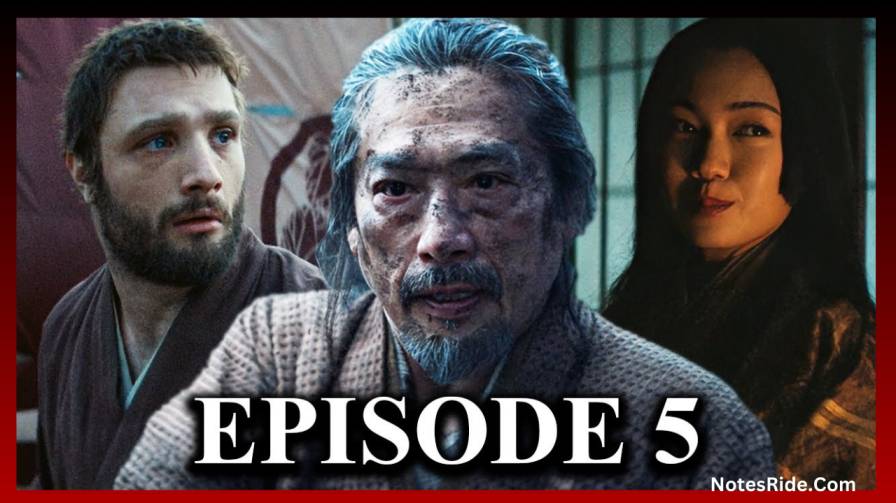SHOGUN Episode 5 Ending Explained: Decoding the Calm Before the Storm

The latest installment of SHOGUN, Episode 5, offers a captivating blend of political intrigue, personal revelations, and impending conflict. As tensions simmer between key players and seismic shifts reshape the landscape, viewers are left with a sense of foreboding as the stage is set for the inevitable clash. Let’s delve into the intricacies of Episode 5 and unravel its pivotal moments.
About Shogun
| Adapted from | Shōgun |
| Executive Producers | Edward L. McDonnell; Justin Marks; Rachel Kondo; Andrew Macdonald; Allon Reich; Michael De Luca; Michaela Clavell |
| Network | Hulu; FX |
| Original Languages | English; Japanese |
| Number of Episodes | 10 |
| Production Companies | Gate 34; Michael De Luca Productions; FXP |
Also Read:
- SHOGUN Episode 4 Ending Explained: The Turning Point of Conflict and Transformation
- The Gentlemen Netflix Ending Explained
- CONSTELLATION Episode 4 Ending Explained
SHOGUN Episode 5 Ending Explained
The Aftermath and New Alliances:
The episode opens with the aftermath of the previous episode’s brutal events, as characters grapple with the repercussions of the slaughter orchestrated by Nagado. Amidst the chaos, new alliances are forged and old enmities resurface, setting the stage for future confrontations.
Tanamoto Akau and The Gardener:
Introduced in the episode are Tanamoto Akau, Toranaga’s trusted spy, and The Gardener, whose significance becomes pronounced as events unfold. Their roles hint at deeper layers of intrigue and foreshadow their impact on the narrative’s trajectory.
Todoro’s Return and Maro’s Dilemma:
The return of Maro’s husband, Todaro, sheds light on Maro’s complex past and the abusive dynamics within their relationship. Maro’s internal struggle is laid bare as she navigates the treacherous waters of her marriage while concealing her burgeoning connection with John Blackthorne.
Toranaga’s Machinations:
Toranaga’s cunning manipulation of political dynamics is on full display as he orchestrates events to his advantage. His calculated moves and strategic foresight position him as a formidable player in the power struggle engulfing feudal Japan.
Blackthorne’s Transformation and Cultural Adaptation:
John Blackthorne’s evolution continues as he embraces Japanese customs and language, earning respect and forging meaningful connections with the people around him. His growing understanding of the intricacies of Japanese society mirrors his personal growth and adaptation to his new environment.
Also Read:
- Shogun Episodes 1 & 2 Ending Explained: Decoding the Intrigue of Feudal Japan
- FEUD: Capote vs. The Swans Episode 5 Ending Explained
- Avatar: The Last Airbender Netflix Ending Explained
Maro’s Revelations and Tragic Past:
Maro’s revelation of her tragic past adds depth to her character, shedding light on the emotional barriers she has erected. Her poignant backstory underscores the themes of loss, resilience, and the enduring quest for redemption amidst a turbulent landscape.
Conflict and Consequences:
As tensions escalate and alliances shift, the specter of war looms large over feudal Japan. Toranaga’s punishment of his son and the council’s deliberations underscore the precarious balance of power and the stakes at play in the impending conflict.
Natural Disaster and Symbolism:
The episode’s climactic earthquake serves as a metaphor for the seismic shifts reshaping Japan’s political landscape. Amidst the devastation, symbols of resilience and renewal emerge, hinting at the resilience of the human spirit amidst chaos and upheaval.
Lady Oba’s Return and Ambitions:
Lady Oba’s return heralds a new era of intrigue and ambition, as she emerges as a formidable player in the power struggle. Her thirst for power and unwavering determination set the stage for future conflicts and betrayals.
Conclusion:
Episode 5 of SHOGUN delivers a masterful blend of political intrigue, personal drama, and impending conflict, setting the stage for the next chapter in this epic saga. As characters grapple with their pasts, navigate shifting alliances, and confront the specter of war, viewers are left on the edge of their seats, eagerly anticipating the unfolding drama that lies ahead.
Final Thoughts:
As SHOGUN enters its midway point, the stage is set for an epic showdown that will shape the fate of feudal Japan. With its rich tapestry of characters, intricate plotting, and evocative storytelling, SHOGUN continues to captivate audiences with its portrayal of a world on the brink of upheaval. As the series hurtles towards its climactic conclusion, viewers can expect more twists, betrayals, and heart-pounding drama in the episodes to come.
FAQs About SHOGUN Episode 5 Ending Explained
Tanamoto Akau is Toranaga’s trusted spy, while The Gardener symbolizes a deeper layer of intrigue, hinting at future plot developments.
Maro’s tragic backstory adds depth to her character, highlighting themes of resilience and redemption amidst turmoil.
Toranaga’s punishment showcases his strategic foresight and his willingness to maintain control amidst shifting alliances.
The earthquake symbolizes the seismic shifts reshaping feudal Japan’s political landscape, hinting at renewal amidst chaos.
Lady Oba’s return heralds a new era of intrigue and ambition, setting the stage for future conflicts and betrayals.
Blackthorne’s adaptation to Japanese customs and language reflects his personal growth and his efforts to bridge cultural divides.
The episode sets the stage for future conflicts and betrayals, hinting at the impending clash between rival factions and the consequences of shifting alliances.
Also Read
